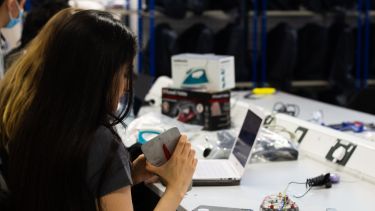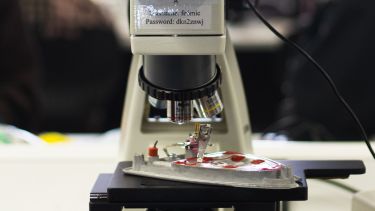The Materials Science display was available throughout August 2022 and January 2023 in the Information Commons exhibition space.
Materials Selection and Fracture Mechanics is a 2nd year module led by Dr Julian Dean (academic lead for artefacts project), Dr Lynne Newcombe (Academic Director for English Language Support Services) and Professor Russell Hand (Module Lead). A new exhibition on Level 1 in the Information Commons highlights artefacts and posters from the module. We spoke to Julian to find out a bit more…
What were the aims and objectives of the module?
Assessment for the module is split evenly between an exam and an artefacts project.
The aim of the project is to allow 2nd year students the freedom to explore the materials in a commercial artefact. We encourage them to set their own research questions and objectives, reporting back their findings to a panel of industrialists and academics.
What did you ask students to do?
We provide the student groups with an artefact, such as a toaster or a kettle. To allow them to compare the commercial aspects, we also provide a cheap and expensive version. We ask the students to set their own ‘research question’ focused around a particular aspect of the artefact, such as environmental impact, cost, or efficiency. The groups then design the experiments that will help answer their question and report their findings back in the form of a presentation and poster.
How did you come up with the idea of using irons?
Every year we choose a different artefact that contains different materials to allow the greatest opportunity for exploration. This year we chose a common household appliance of an iron which has key parts made from metals (baseplate), ceramics (coatings) and polymers (housing). Previous years we have studied toasters and the difference between male and female razor blades!
How does this module fit within the overall programme of study?
The artefacts project builds on the students first two years of knowledge of their course, using skills and understanding obtained from both lectures and practicals. For instance, our students are trained in using laboratory equipment such as scanning electron microscopy and thermal analysis techniques. This project provides them the opportunity to use and develop these skills for the final years of their degree. Being able to clearly articulate their findings to industrial partners is also crucial for any student whether they find a role in industry or academia. Being asked to present findings to an industrial panel in the form of a talk and poster presentation provides really good experience.
What methods of teaching were used?
This year we have had support from the English Language Support Services, which has been fantastic. For the first five weeks, Dr Lynne Newcombe worked with our students to help provide them experience in presenting their work as posters or oral presentations. This involved looking at previous years posters to work out what works well in a poster and what doesn’t. We also ask the students to present a research paper of their choosing to the year in the form of a group presentation, where feedback is provided in order for them to improve before the assessed presentation. After the presentations, we asked the students to produce an action plan, to think of key things they want to use in their project. At the end of the project we ask them to reflect on this and how the group project went.
How do students benefit from the sponsorship of the Worshipful Company of Tin Plate Workers?
Whilst the marks from the project contribute 50% to the final module grade there is also a competitive element. We are very thankful for the Worshipful Company of Tin Plate Workers alias Wire Workers for their generous donation of £2200 each year along with their time to support our students, assess them and provide feedback. There are prizes to groups for best poster, best presentation and best overall project. The best overall group have also been invited to apply to become Yeomen of the Company!
How did students feel about the module? Do students enjoy its flexibility?
Student feedback has always been really positive and they enjoy being able to explore and design their own project. As with any group project, it can vary from group to group and experiences can be dependent upon group members, however these are all key learning points and many issues are worked out throughout the project.
Of all the objects that your students have worked on, which is your favourite?
Male and female razor blades - which could be considered as a cheap and expensive variant of a razor blade. The results were really interesting. The students found that there was little difference between the two, and definitely no reason for such different price points. In fact, they found the handles of the female razor blades were cheaper to manufacture than the male versions. One group decided to use the bio-bacterial laboratory in the Diamond to ‘grow’ bacteria on the handles in the wet environments we usually keep them in. While the male equivalents with their metal handles didn’t support much growth, the plastic handles with designed holes and curves could support growth of some nasty things!
Blog post written by Dr Julian Dean, Dr Lynne Newcombe and Prof Russell Hand.



